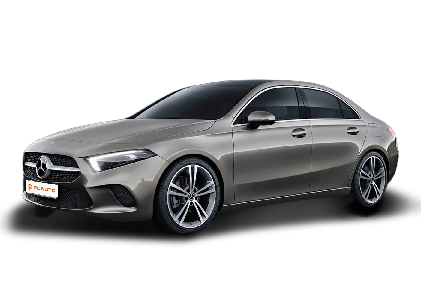Q
What is the average fuel consumption of Mercedes A Class?
The Mercedes A-Class offers various models with different fuel efficiency figures. The models equipped with a 1.3T engine have an official combined fuel consumption of 5.4L/100km, while those featuring a 2.0T engine report an official combined fuel consumption of 6.3L/100km. However, real-world fuel consumption can be influenced by driving habits, road conditions, vehicle load, and other factors, which often leads to discrepancies from the official figures.
For instance, some real-world tests and owner feedback indicate that actual fuel consumption might be higher than those official numbers. Understanding these variations can assist potential buyers in making informed decisions by considering their own needs and factoring in fuel economy when selecting a vehicle.
Special Disclaimer: This content is published by users and does not represent the views or position of PCauto.
Related Q&A
Q
How much is the cheapest Mercedes 2024?
The cheapest Mercedes-Benz model in Malaysia for 2024 is expected to be the A-Class Sedan, with a starting price of around RM220,000 (exact pricing may vary based on configuration, taxes, or promotional offers). This compact luxury sedan is powered by a 1.3-liter turbocharged engine, available in different tunes producing 136 hp to 163 hp, making it ideal for consumers seeking brand value and urban driving agility. If your budget is tight but you still want to experience Mercedes technology, keep an eye on their Certified Pre-Owned (CPO) program, which typically offers 15%-30% savings. It's worth noting that Mercedes-Benz locally assembles (CKD) some models in Malaysia to reduce costs, such as the C-Class and GLC, but the A-Class is currently still sold as a fully imported (CBU) unit, hence the higher price. German rivals in the same segment like the BMW 2 Series Gran Coupe or Audi A3 are similarly priced but focus on different features, so it's advisable for consumers to test drive and compare based on their needs. Additionally, Mercedes-Benz Malaysia often provides low-interest financing or free service packages, so be sure to check with authorized dealers for the latest promotions before purchasing.
Q
Is the A-Class a family car?
To some extent, the A-Class can be considered a family vehicle. It features a four-door, five-seat layout that provides ample space for small families. The 60:40 split-folding rear seats offer flexibility for accommodating both passengers and cargo. With a fuel tank capacity of 51 liters, it allows for long-distance travel without frequent refueling stops.
Safety is prioritized with multiple airbags, an Anti-lock Braking System (ABS), and Electronic Stability Control, ensuring the safety of the entire family during trips. Inside, the car is equipped with a fully digital instrument cluster, a touchscreen central display, and a premium sound system featuring 10 speakers, providing a comfortable driving experience and entertainment enjoyment.
However, as a compact car, the interior space may not be as roomy as some larger family vehicles. Overall, it combines practicality, safety, and comfort, making it suitable for family use.
Q
Which model of A-Class is the fastest?
Among the models offered, the 2023 Mercedes-Benz A-Class Sedan A250 4MATIC AMG Line is the fastest, boasting a top speed of 250 km/h and an official 0-100 km/h acceleration time of 6.3 seconds. This vehicle features a displacement of 1991 mL and utilizes a turbocharged intake system, with a maximum power output of 224 PS.
Generally speaking, a vehicle's top speed and acceleration times are influenced by various factors, including engine performance, vehicle weight, and the transmission system. The A250 4MATIC AMG Line benefits from a relatively large displacement and a powerful turbocharged engine, giving it a significant advantage in power delivery and enabling faster speed performance. In comparison to other A-Class models, it stands out in terms of dynamic capabilities.
Q
Where is Mercedes A-Class made?
The Mercedes-Benz A-Class is manufactured in Rastatt, Germany. The Rastatt plant is located more than 100 kilometers west of Stuttgart. It primarily produces compact cars, including the new A-Class, the updated B-Class luxury sports tourer, and the compact SUV – GLA. Currently, the plant’s annual production exceeds 200,000 units.
This facility plays a significant role in the production of Mercedes-Benz’s compact car lineup, ensuring that models like the A-Class can meet global market demand. The manufacturing process here adheres to Mercedes-Benz’s high standards of quality and precision, utilizing advanced technology and implementing stringent quality control measures to ensure that the A-Class vehicles that roll off the assembly line meet exceptional performance and quality standards.
Q
What is the top speed of Mercedes A-Class?
The top speeds of different models in the Mercedes A-Class vary, with the A200 model achieving a maximum speed of 230 km/h, while the A250 can reach up to 250 km/h. In addition to engine power and torque, several other factors, including aerodynamic drag coefficient, tire specifications, and suspension tuning influence a vehicle's top speed.
For instance, a powerful engine combined with a low drag coefficient results in reduced air resistance, which is beneficial for achieving higher speeds. Additionally, good tire grip and stable suspension tuning ensure the vehicle’s safety and stability at high speeds, further supporting its ability to reach elevated top speeds.
Q
What is the lifespan of Mercedes engine oil ?
The lifespan of Mercedes engine oil can vary based on several factors. Generally speaking, when using fully synthetic oil, the typical replacement interval is around 10,000 kilometers or one year. For example, the 5W-40 fully synthetic oil used in the Mercedes A-Class follows this replacement schedule. However, this is not an absolute standard, as actual usage should be adjusted according to the vehicle's specific condition and operating environment.
For instance, if a vehicle is frequently driven in high-temperature, high-load, or dusty conditions, the oil may degrade more quickly, necessitating an earlier change. Additionally, if you notice changes in oil viscosity, unusual odors, or significant discoloration, you should consider replacing the oil even if the specified time or mileage has not yet been reached.
Furthermore, the shelf life of unopened leftover oil after servicing is typically one year. Once opened and sealed properly, it’s best to use the oil within six months under ideal storage conditions. The oil that has been poured into the engine has an effective lifespan of about six months.
Q
Does a Mercedes A Class have a service book?
The Mercedes A-Class typically comes with a service manual (maintenance handbook). This manual contains essential information regarding vehicle maintenance, including service items, maintenance intervals, and mileage recommendations. It helps owners understand when and what type of servicing their vehicle requires, ensuring that it remains in excellent condition. Vehicle owners can obtain a printed version of the service manual from the dealership where they purchased their car. Additionally, some electronic PDF versions are available for free download to mobile devices, making it convenient for owners to access the information at any time, often obtainable through relevant website links. Familiarizing themselves with this information enables vehicle owners to effectively schedule maintenance, thus prolong the lifespan of their cars.
Q
Is Mercedes A-Class expensive to fix?
The maintenance costs for the Mercedes A-Class are relatively high, positioning it at a medium level among luxury brands. As a luxury brand, Mercedes vehicles feature high standards in design, materials, and manufacturing processes, which contributes to higher prices for certain parts and repair services. A basic service, including oil and filter changes, costs approximately 900 Malaysian Ringgit, while a three-year, 60,000-kilometer maintenance service amounts to around 8,831 Malaysian Ringgit (excluding labor fees).
Maintenance services are divided into A service and B service. The A service mainly involves an oil change and oil filter replacement, costing between 858 and 1,008 Malaysian Ringgit, whereas the B service is priced at around 1,200 Malaysian Ringgit. The cost of maintenance varies depending on driving mileage, with services at 10,000 kilometers and 50,000 kilometers being less expensive, while the service at 60,000 kilometers is the most costly. However, repair costs can differ based on the specific service, scope of repair, and regions. Furthermore, Mercedes has a comprehensive after-sales service network and offers various service plans, which can help vehicle owners reduce maintenance costs to some extent.
Q
Which model of Mercedes A-Class is the best?
Each variant of the Mercedes A-Class has its unique advantages, making it difficult to determine which model is the "best." The A200 Progressive Line is priced at RM 238,888, featuring a 1.3L engine with an official 0-100 km/h acceleration time of 8.1 seconds and a combined fuel consumption of 5.4L/100km, making it suitable for those who value a smooth driving experience and low fuel consumption.
On the other hand, the A250 4MATIC AMG Line is priced at RM 263,888 and boasts a 2.0L engine with a maximum output of 224 PS and a 0-100 km/h acceleration of just 6.3 seconds. This model offers robust performance, appealing to those with high demands for power and a desire for a thrilling driving experience.
If your budget is limited, consider the older model, such as the 2021 A200 Progressive Line, which is available at a more affordable price of RM 220,458. Conversely, if your budget allows and you seek high performance, the new A250 4MATIC AMG Line would be an excellent choice. Ultimately, the best model depends on individual factors such as budget, performance requirements, and fuel consumption preferences.
Q
How much oil does a Mercedes A-Class take?
The fuel consumption of different Mercedes A-Class models varies. For the official combined fuel consumption, the model equipped with a 1.3L turbocharged engine has a fuel consumption of 5.4L per 100 kilometers, while the variant with a 2.0L turbocharged engine records a fuel consumption of 6.3L per 100 kilometers.
However, real-world fuel efficiency can differ from official figures due to various factors such as driving habits and road conditions. For instance, frequent aggressive acceleration, harsh braking, repeated starts and stops, or driving in congested traffic typically result in higher fuel consumption. Conversely, maintaining a smooth driving style, shifting gears appropriately, and driving on good roads can help achieve fuel efficiency closer to the official figures.
Additionally, factors such as vehicle load and tire pressure can also impact fuel consumption. Understanding these influencing factors can assist owners in better managing their fuel efficiency.
Popular Cars
Model Year
Car Compare
Car Photo
Latest Q&A
Q
Is the 3.0 L V6 a good engine?
The 3.0L V6 is widely regarded as a smooth and potent powerplant, perfect for drivers who crave effortless performance. It truly shines during highway cruising or heavy-load scenarios, thanks to its inherent balance from the six-cylinder layout. Compared to four-cylinder mills, the V6 delivers superior refinement, quieter operation, and more linear torque delivery - making it an ideal match for luxury sedans or SUVs.
That said, there are trade-offs. You won't get the same fuel efficiency as smaller turbocharged engines, and maintenance costs tend to run higher. For stop-and-go city commuting, it might feel like overkill. But modern iterations have come a long way - technologies like direct injection and variable valve timing have significantly improved gas mileage.
For enthusiasts who appreciate the progressive power delivery of naturally aspirated engines, the 3.0L V6 remains a compelling choice. Just remember that actual performance can vary depending on how each manufacturer tunes and integrates the engine into their vehicles.
Q
Is a 3L engine a V6?
A 3L engine doesn’t automatically mean it’s a V6. Displacement (3 liters) and cylinder arrangement (V6) are two separate things. A 3-liter engine can come in different layouts—inline-4, V6, straight-6, even V8—depending on the manufacturer’s goals. For example, an inline-6 might prioritize smoothness, while a V6 could save space.
Speaking of V6s, they split cylinders into two banks in a V-shape, three per side, balancing power and compactness. That’s why you’ll often see them in premium models.
Here’s the twist: modern turbocharging lets smaller engines punch way above their weight. A 2.0T can easily hit 300+ horsepower, rivaling many 3L naturally aspirated units. So judging performance by displacement alone? Outdated.
Also, tech like direct injection and variable valve timing plays a huge role in real-world performance. My advice? Look beyond cylinder count or displacement—focus on power curves, torque delivery, and most importantly, how it actually drives.
Q
Is a 2.4 L engine a 4 cylinder?
A 2.4-liter engine is typically a 4-cylinder setup, though the exact cylinder count depends on the engine type and brand philosophy. Many naturally aspirated or turbocharged 2.4L mills do use an inline-four configuration—think common Japanese or American four-bangers. This layout strikes a decent balance between power and fuel efficiency. That said, there are exceptions: some high-performance or specialty 2.4L engines (like those in certain sports cars or off-roaders) may pack six or even more cylinders.
Cylinder count affects an engine’s smoothness and power delivery. Four-pots are generally more compact and cheaper to maintain, making them ideal for daily drivers. Six-cylinders and up deliver stronger performance but guzzle more fuel—your choice depends on driving needs and budget. Worth noting: modern turbocharging has blurred the lines, with many turbo-four engines now matching the punch of older six-cylinders. That’s been a big trend lately.
Q
Which engine is better, 5.0 or 3.5 EcoBoost?
The 5.0L naturally aspirated engine and 3.5L EcoBoost turbocharged unit each have their strengths—it really comes down to what you're after. The 5.0L V8 is all about that linear power delivery and iconic growl, perfect for drivers who crave that traditional big-displacement thrill. It shines on highway cruises with rock-solid stability, though expect heavier fuel consumption.
The 3.5L EcoBoost, on the other hand, uses twin turbos to deliver power more efficiently, punching out serious low-end torque—ideal for city driving and fuel-conscious buyers. Don't underestimate its tuning potential either. Both engines are proven reliable, but maintenance differs: the 5.0L's simpler design battles higher displacement taxes, while the EcoBoost demands diligent turbo system care.
Here's the thing: turbos are becoming the norm with tightening emissions rules, but the NA V8 still has its die-hard fans. My advice? Let your daily needs and budget guide you, and definitely test-drive both to feel how they deliver power differently. Night-and-day experience.
Q
What does a 3.0 L engine mean?
A 3.0L engine refers to a total displacement of 3.0 liters, meaning the combined working volume of all cylinders is 3,000 cubic centimeters. Generally, a larger displacement translates to more power, though at the cost of higher fuel consumption. This type of engine is often found in performance cars or luxury vehicles, as it delivers stronger torque and horsepower—ideal for drivers who prioritize the thrill of driving.
That said, displacement is just one factor affecting performance. Technologies like turbocharging, cylinder arrangement (V6, inline-six, etc.), and fuel injection systems also play a big role in real-world performance. Nowadays, many automakers use turbocharging or hybrid systems to help smaller engines achieve power levels close to those of larger-displacement engines while improving fuel efficiency.
If you value raw power, a naturally aspirated 3.0L engine’s smooth, linear delivery might be what you’re after. But if daily running costs and eco-friendliness matter more, a downsized turbocharged or hybrid option could be the smarter pick.
View MoreRelated News

Brand New Mercedes-Benz GLC with EQ Technology Coming Soon: A Larger, Faster, and More Efficient Luxury All-Electric SUV
LienDec 11, 2025

Mercedes-Benz GLC200 4Matic debuts, offering a more accessible entry price at RM329,888
LienDec 11, 2025

Mercedes-Benz invests in an autonomous driving technology company under Geely named Qianli
AshleySep 25, 2025

Benz launches its first car equipped with solid-state batteries, capable of traveling 1,205 kilometers on a full charge
WilliamSep 10, 2025

Mercedes-Benz electric vehicle design language will also undergo a major change to respond to BMW Neue Klasse.
JamesSep 9, 2025
View More


















Pros
Cons